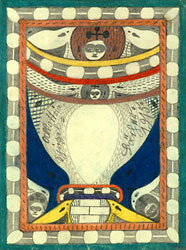 |
Adolf Wolfli
1864-1930
Born in Bowil, Switzerland
 Adolf Wolfli's childhood was one of degradation and indigence. The youngest of the seven children born to a stonecutter and a laundress, Wolfli, orphaned before his tenth birthday, was made a ward of the community and lived in a succession of wretched foster homes. Forbidden to court the girl he loved by her scornful father, Wolfli temporarily abandoned life as an itinerant farm laborer in 1883 to join the infantry. In 1890, he was sentenced to two years in prison for the attempted molestation of two young girls, and in 1895, after a third incident of alleged molestation of a three-and-a-half-year-old-girl, he was committed to the Waldau Psychiatric Clinic in Bern, where he remained until his death in 1930. Suffering from terrifying hallucinations, Wolfli was often placed in isolation during the first decade of his hospitalization. From 1910, working systematically on his writing and drawing, Wolfli desired the solitude and protection of a private cell, which he decorated with his own works. Adolf Wolfli's childhood was one of degradation and indigence. The youngest of the seven children born to a stonecutter and a laundress, Wolfli, orphaned before his tenth birthday, was made a ward of the community and lived in a succession of wretched foster homes. Forbidden to court the girl he loved by her scornful father, Wolfli temporarily abandoned life as an itinerant farm laborer in 1883 to join the infantry. In 1890, he was sentenced to two years in prison for the attempted molestation of two young girls, and in 1895, after a third incident of alleged molestation of a three-and-a-half-year-old-girl, he was committed to the Waldau Psychiatric Clinic in Bern, where he remained until his death in 1930. Suffering from terrifying hallucinations, Wolfli was often placed in isolation during the first decade of his hospitalization. From 1910, working systematically on his writing and drawing, Wolfli desired the solitude and protection of a private cell, which he decorated with his own works.
After four years in the Waldau clinic, Wolfli began to draw. The earliest preserved works, dating from 1904, are restless, symmetrical pencil drawings on newsprint. Combining images, words, and musical notations, the early works forecast the principal motifs and pictorial devices of his later work. In 1908, the year Dr. Walter Morgenthaler arrived at Waldau, Wolfli embarked upon the epic autobiographical project that would consume the remaining twenty-two years of his life. The text of the fanciful autobiography, interspersed with poetry, musical composition, and three thousand illustrations, comprises more than twenty-five thousand pages.  Hand bound by Wolfli and stacked in his cell, the forty-five volumes eventually reached a height of more than six feet. Intermingling reality and fiction, Wolfli's autobiography begins as an adventurous geographical world expedition, of which Doufi (Wolfli's childhood name) is the hero, and expands to a grandiose tale of cosmic war, catastrophe, and conquest with Doufi transformed into St. Adolf II. The fascinating illustrations of the narrative are labyrinthine creations and mandalalike compositions of densely combined text and idiosyncratic motifs. Hand bound by Wolfli and stacked in his cell, the forty-five volumes eventually reached a height of more than six feet. Intermingling reality and fiction, Wolfli's autobiography begins as an adventurous geographical world expedition, of which Doufi (Wolfli's childhood name) is the hero, and expands to a grandiose tale of cosmic war, catastrophe, and conquest with Doufi transformed into St. Adolf II. The fascinating illustrations of the narrative are labyrinthine creations and mandalalike compositions of densely combined text and idiosyncratic motifs.
A few days before his death, Wolfli lamented his inability to complete the final section of the autobiography, a grandiose finale of nearly three thousand songs, which he titled "Funeral March". In 1972, Wolfli's work was exhibited at Documenta 5 and since then has been shown throughout Europe and the United States. In 1975, forty-five years after his death, Wolfli's staggering artistic production — including the autobiography and its illustrations, as well as some eight hundred loose leaf drawings-was transferred from the Waldau Psychiatric Clinic to the Kunst Museum in Bern.
Source: Barbara Freeman, Biographies of Outsider Artists in "Parallel Visions: Modern Artists and Outsider Art," Copyright 1992 by Museum Associates, Los Angeles County Museum of Art, Princeton University Press, Reprinted by permission of the copyright holder.

|
 |